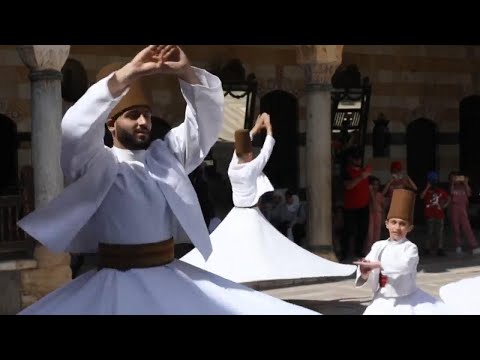(20 Jun 2024)
SYRIA WHIRLING DERVISHES
SOURCE: ASSOCIATED PRESS
RESTRICTION SUMMARY:
LENGTH: 4:48
ASSOCIATED PRESS
Damascus, Syria – 6 June 2024
1. Wide of whirling dervishes twirling
2. Mid of Muhammad Imad al-Din al-Kharrat twirling
3. Mid of Bashar Imad al-Din al-Kharrat twirling
4. Wide of student twirling
5. Mid of student twirling
6. Various of students twirling
7. SOUNDBITE (Arabic) Muhammad Imad al-Din al-Kharrat, dervish dancer:
"Mawlawiyya is a Sufi method derived from our master Jalaluddin Rumi. We inherited it from our ancestors and are teaching it to our children. We are approximately 20 or 25 Mawlawi people from one family. I have been practicing as a Mawlawi for about 20 years, and we are continuing on. We love it because it gives a good feeling to continue the legacy started by our grandfathers, fathers and uncles. Our cousins and kids are now learning this too."
8. Various of students training
9. SOUNDBITE (Arabic) Bashar Imad al-Din al-Kharrat, dervish dancer:
"We, as a whole family, practiced this after learning it from our fathers and grandfathers. We loved the rituals and the work. The spirituality of it connects us with God Almighty. We loved it very much. The white dress is the main dress of the Mawlawiyya. It is a loose-fitting garment that expresses serenity and purity. The movements made in the Mawlawiyya way represent symbols."
10. Various of dervishes putting on costumes
11. Various of Bashar Imad al-Din al-Kharrat and Muhammad Imad al-Din al-Kharrat putting on clothes on child
12. SOUNDBITE(Arabic) Bashar Imad al-Din al-Kharrat, dervish dancer:
"The white dress is loose clothing that represents the afterlife and the shroud. The tarboosh (hat) symbolizes the color of dirt, and its length symbolizes martyrdom."
13. Various of Bashar Imad al-Din al-Kharrat teaching student
14. SOUNDBITE(Arabic) Bashar Imad al-Din al-Kharrat, dervish dancer:
"The main name for it is Mawlawiyya. Everyone calls it something different. Some people call them (the performers) the dervishes. The dervishes are the Mawlawi. They call us dervishes because the Mawlawiyya is simple. A Mawlawi is close to God. You feel his spirituality. He does not desire the pleasures of this world; he desires the afterlife. He wants nothing from this world at all, only the afterlife and not the worldly enjoyment."
15. Various of whirling dervishes
STORYLINE:
In a 17th-century palace in Damascus, a group of men perform the Sufi spiritual practice of whirling.
The more they whirl, the closer they feel to God.
The Mawlawiyya is an ancient Islamic practice from the 13th century founded by the Sufi Persian mystic and poet Jalal al-Din Rumi.
Many versions of whirling, dancing and chanting exist around the Middle East, and in Syria, it is a family tradition.
The al-Kharrat family has been dervishes for generations, performing all over the world.
The art form is dying, leaving only a few families like the al-Kharrat to keep the practice alive.
Passing on the knowledge from generation to generation is crucial to preserving the tradition for the future.
“We love it because it gives a good feeling to continue the legacy started by our grandfathers, fathers and uncles. Our cousins and kids are now learning this too,” says Muhammad Imad al-Din al-kharrat, a member of the troupe.
In 2005, the United Nations’ cultural body, UNESCO, proclaimed the dervishes’ ritual a masterpiece of “the oral and intangible heritage of humanity.”
Many traditional practices have suffered, including the Mawlawiyya.
AP video shot by Abdulrahman Shaheen
Find out more about AP Archive: http://www.aparchive.com/HowWeWork
Twitter: https://twitter.com/AP_Archive
Facebook: https://www.facebook.com/APArchives
Instagram: https://www.instagram.com/APNews/
You can license this story through AP Archive: http://www.aparchive.com/metadata/youtube/d5f5aad72e06442b834db548d8406b5e





